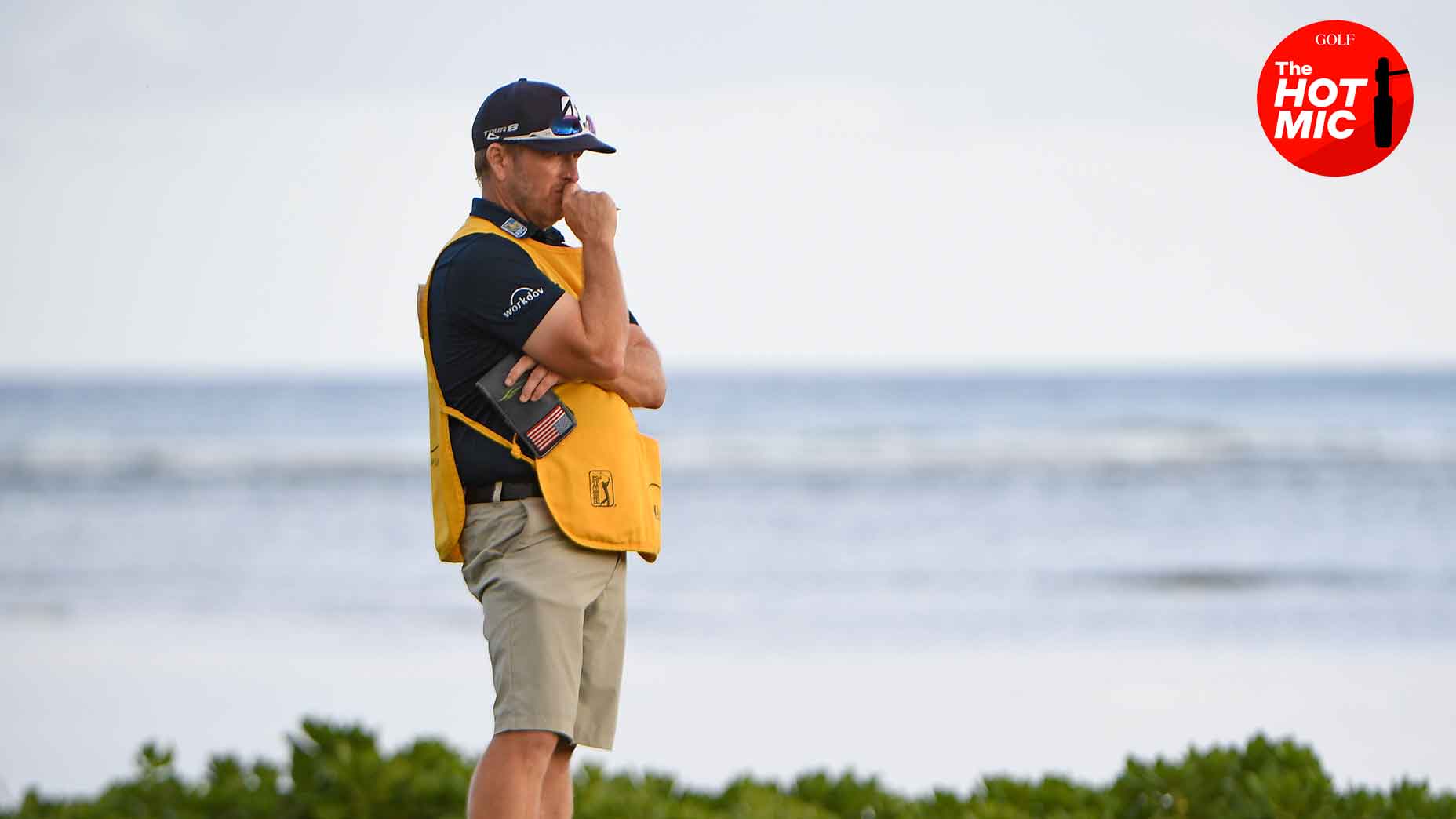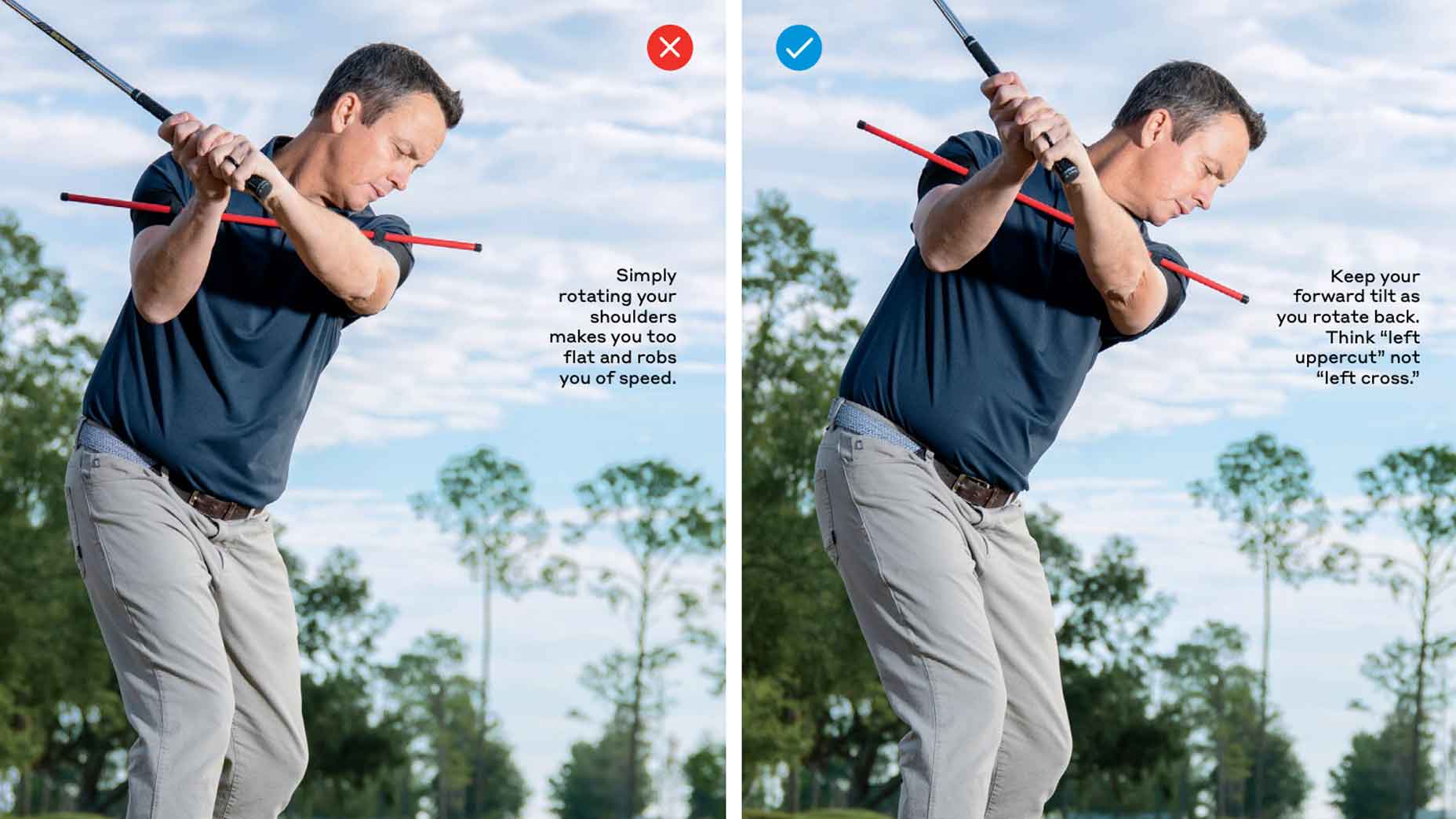It wasn’t long ago that people thought golfers weren’t athletes. Ditto the outdated notion that all caddies are slackers, smokers and scofflaws. Get real. The men and women in smocks today are more essential to the pro game than ever. Part stats nerd, part guru, part pack mule and therapist, a typical looper is both at the center of the action and a side player. What follows this week (and in the Jan./Feb. 2024 pages of GOLF Magazine) is a snapshot of the life — and loads of intel for your game.
CADDYING 101
Undoubtedly, it demands a strong back. And it helps to have a way with a towel, a rake and a rowdy gallery. But few golf fans know what it really takes to do the heavy lifting on Tour. Let’s detail the caddie basics.
***
It’s 1997, and a hotshot has landed on the PGA Tour. His last name? Woods. A story we all know well. At that same time, just down the driving range, another young buck has arrived. The name is similar — Wood — but the job is different: caddie for Kevin Sutherland.
“Since we came out at the exact same time,” John Wood says, “I joke with Tiger that it’s questionable who really made the purses go up.”
We all know who wins that debate, but few people on earth know the caddie profession better than “Woody.” After 24 years on the bag — for Sutherland, Hunter Mahan and Matt Kuchar, among others — he smoothly transitioned in 2021 to an on-course reporting gig with NBC Sports. Still, for a crash course on the intricacies of the looping experience, he’s your guy.
LESSON 1: GOING INTO THE GIG, PREPARE TO BE SURPRISED
“You think you know golf,” Wood says. “You play some decent amateur tournaments, college golf, and you think you know what high-level golf is. But the difference on the PGA Tour is so drastic. The attention to detail really blew me away. I thought I knew what I was doing coming in. I didn’t have a clue. You learn that very quickly.”
LESSON 2: DON’T MISTAKE TODAY’S CADDIE JOB FOR THE OLD CADDIE JOB
“Back in the late ’90s, when I came on Tour, it was easier for a good caddie to stand out. There’s so much more involved now, so many more tools to use. The yardage books have developed to an unbelievable place. When I started out, it was very basic — front yardages, maybe a couple carry yardages. You had to do a lot of the work yourself. Go out there on Tuesday, run through numbers on the tee shots, do a lot more greens work. Caddies are more involved now in everything to do with a player’s game.”
LESSON 3: THE LIST OF THINGS A LOOPER NEEDS TO DO REALLY WELL IS LONG
“The x’s and o’s are easy. You can learn how far a guy hits his 7-iron in half a round. The important part begins with knowing their strengths and weaknesses. What is he good at? What is he not so great at? You have to read your guy. Is he down in the dumps and needs to be reminded, ‘Hey, you are not that far off.’ Other times, you need to get in his face and say, ‘You’re not going to find your best golf acting like you’re acting right now.’ He has to know you are his biggest supporter, that you want to win this golf tournament as much as he does. On course, you need all the carry numbers, all the green slopes, all the areas where you can and can’t miss. I might communicate a list of holes I think are birdie holes that day. We absolutely need to know wind direction. It completely changes the course. If you’ve got rain coming, you need to think about how much the ball will be spinning. It changes every single shot. Greens don’t break as much when there is water on them.”
LESSON 4: YOU’LL LOG PLENTY OF HOURS ALONE ON THE COURSE
“In a typical week, most caddies will walk the course without their player, which is two to three hours. Some do extra work on the greens, going out to just roll putts. That’s another hour or two. Then every night or morning there’s about an hour of homework, pregame stuff you’re doing that your player doesn’t know about. Guys bring their books back to the hotel, go over pin locations and start matching that up with wind direction. Then some weeks — like at the majors — where the line between good and bad is so fine, if you’re not playing in the morning, you’ll go out and actually watch for things you wouldn’t see on TV. If Patrick Cantlay is in contention at the Masters Saturday night, you’ll see Joe LaCava out there Sunday morning in a New York Giants football shirt watching golf.”
John Wood’s stellar NBC debut proves caddies are at home as golf analystsBy: James Colgan
LESSON 5: THERE’S ACTUALLY AN EASY PART OF THE JOB
“As long as you have a decent bag, you’re only working 25 to 28 weeks a year. Whether you have a family at home that you spend a lot of time with or you have a lot of interesting hobbies that you want to pursue, you do get a ton of time off, and that’s great.”
LESSON 6: BUT THERE’S ALSO THE TOUGHEST PART TOO
“When your player is in a slump and you are grinding to figure it out, that’s rough. Is it something I need to say? Is it something physical his coach needs to handle? If you care about it, you take it home at night. You might be having a conversation with somebody at dinner, but in your mind you’re going, Okay, what if I tried this? What if I said this out there?”
LESSON 7: CADDIES WERE THE ORIGINAL STATS NERDS
“With the advent of analytics and statistics, players hire statisticians now, but the best caddies have always had that information. It may not have been ‘You miss to the right 15.4 percent of the time,’ but you knew their tendencies way before analytics and statistics came in. You knew when they had downhill left-to-right putts, they always underread it. You knew when they were hitting into the wind and tried to flight it, they’d usually balloon it a little. Steve Williams was one of the first guys I noticed who would keep track of that stuff, and he got me doing the same thing.”
LESSON 8: SPEAKING UP ISN’T COURAGEOUS, IT’S A MUST
“My first year out, Kevin [Sutherland] had a bit of a slump. I remember sitting down in Houston and he said, ‘I need you to think like a player. I’m not going to be right every time. That’s why I brought you out here. I want to hear your opinion. Right or wrong, it’s going to be my decision ultimately. But I don’t need you to agree with everything I’m saying.’ It was like a light bulb went on for me. I can say whatever I want. I can be wrong, but I need to state my truth because that’s what a caddie is being paid for.”
LESSON 9: SOME OF IT MAKES NO SENSE AT ALL. GET USED TO IT.
“You can do a perfect job as a caddie and not make a dime because your guy’s not playing well, and you can do a crap job and have a great player and make a ton of money. That’s tough — you’re doing everything you can and nothing’s working. There comes a time when you ask yourself: Is this the guy I want to be working for? Would he be better suited with somebody else? Yeah, it’s one of the strangest jobs in the world.”











